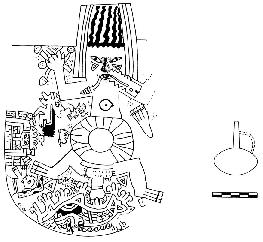| Site: Nasca | | Clados Number: 271 | | Culture: Nasca | | Description: bottle, ID number missing, Museo Larco Herrera, Lima. | | Chronological Era: Early Intermediate Period (EIP), Nasca 7 Phase. | | Iconographic Features: an unusual Nasca 7 bottle with a ritual scene. A naked man lies on its back surrounded by the Killer Whale Mythical Being and animals (fox, mice, birds). To his right a woman and a Rayed Face with trident crown and seven (banded) arms/paws is shown. To his left a panpipe appears. The man holds a couple of rattles, a rattle and a fish are placed in his mouth. A similar scene was published by Tello (1959, pl. 90). | |
| 
Rollout © 2003 Christiane Clados
Click to view high resolution in a new window
select this image for review |
